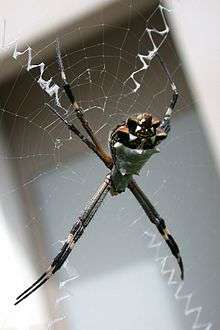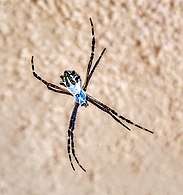Argiope argentata
Argiope argentata is a species of spider in the family Araneidae (orb-weavers), found from the United States south to Chile and Argentina.[1][2] It is a member of the genus Argiope and is commonly known as the silver argiope.[3]
| Argiope argentata | |
|---|---|
 | |
| Female in California (dorsal side) | |
| Scientific classification | |
| Kingdom: | Animalia |
| Phylum: | Arthropoda |
| Subphylum: | Chelicerata |
| Class: | Arachnida |
| Order: | Araneae |
| Infraorder: | Araneomorphae |
| Family: | Araneidae |
| Genus: | Argiope |
| Species: | A. argentata |
| Binomial name | |
| Argiope argentata | |
| Synonyms[1] | |
| |
Description
As with most members of the genus Argiope, the female of the species tends to be much larger than the male.[4] The body of Argiope argentata tends to be primarily silver with brown and orange colorations further back on the abdomen on the top, and with a primarily brown underbelly. The legs have bands of orange, black, and silver. The female can be up to 35 mm in length whereas the male tends to be 20 mm or less.
Females of the Argiope blanda species are very similar to Argiope argentata females. The species can potentially be distinguished due to the four projections on the abdomen being more rounded on A. argentata, differing ventral markings, differing genitalia (the only sure distinguisher), and within the United States, A. blanda's range being limited to the southern tip of Texas.[2][5][6][7]
Reproduction
Silver argiopes are sexually cannibalistic.[8]
Web
Like other members of Argiope, silver argiopes often spin stabilimenta into their webs.[2][4] These often take the form of zigzag lines,[2][4] and frequently there are four of them[2] forming a centerless "X" shape near the center of the web; the spider then rests in the very middle, with four pairs of legs each drawn together and splayed out in an "X" shape more or less aligned with the stabilimentum "X".
Silver argiopes' webs are often also home to dewdrop spiders (Argyrodes). These are small kleptoparasitic or commensal spiders which feed on insects trapped by their host's web.[2][4]
.jpg)
Habitat
The range of Argiope argentata extends from the USA in the north (between southern California and Florida) to as far as Argentina in the south,[2] although it prefers warmer, dryer areas. They can often be found on prickly pears in the fall.[4]
Gallery
 Female in California (ventral side)
Female in California (ventral side)- Female in the Galápagos Islands
.jpg) Female in Jamaica
Female in Jamaica_with_victim.jpg) Female with victim (a bush cricket) in Jamaica
Female with victim (a bush cricket) in Jamaica Southern California
Southern California
References
- "Taxon details Argiope argentata (Fabricius, 1775)". World Spider Catalog. Natural History Museum Bern. Retrieved 2016-05-08.
- Berrian, Jim. "SDNHM: Silver Argiope spider (Argiope argentata)". www.sdnhm.org. San Diego Natural History Museum. Archived from the original on 2012-01-04. Retrieved 2017-08-16.
- Smithsonian Institution. "Smithsonian Tropical Research Institute-Argiope argentata". biogeodb.stri.si.edu. Retrieved 2017-08-16.
- Bryant, Peter J. (2015-12-28). "Silver argiope, Argiope argentata". mamba.bio.uci.edu. University of California, Irvine. Retrieved 2017-08-16.
- Elliott, Lynette; Heins, Chad (2015-07-16). "Species Argiope blanda - BugGuide.Net". Retrieved 2017-08-16.
- Elliott, Lynette; M, Katherine (2012-12-14). "Possible blanda (ID not verified) - Argiope blanda - BugGuide.Net". Retrieved 2017-08-16.
- Elliott, Lynette; Burton, Henry; Ferguson, David J.; Edmonds, Matt (2012-12-14). "WHAT IS THIS SPIDER - Argiope - BugGuide.Net". Retrieved 2017-08-16.
- Ghione, Soledad; Costa, Fernando G. (April 2011). "Female attack is not necessary for male copulatory organ breakage in the sexually cannibalistic spider Argiope argentata (Araneae: Araneidae)". Journal of Arachnology. 39 (1): 197–200. doi:10.1636/Hi10-92.1. ISSN 0161-8202.
External links
- Argiope argentata images (free for noncommercial use)
| Wikimedia Commons has media related to Argiope argentata. |
| Wikispecies has information related to Argiope argentata |